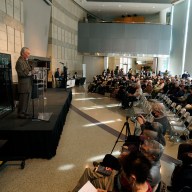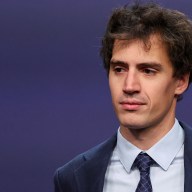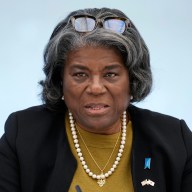BEIJING – Cheering mountaineers raised the Olympic torch at the summit of the world’s highest peak Thursday, producing the triumphant image that China has longed for in the run-up to the Beijing Olympics.
The final ascent along Mount Everest’s icy ridge was broadcast live and provided organizers with a dramatic counterpoint to the pro-Tibet protests that marked parts of the torch’s international relay.
“One World, One Dream,” team captain Nyima Cering, a Tibetan, yelled in English as his torch was lit a few yards from the summit – the slogan for the Beijing Olympics in August.
The 19-member team, dressed in red parkas emblazoned with Olympic logos, broke camp at 8,300 metres before dawn and reached the top of the 8,850-metre mountain a little more than six hours later.
The flame was passed up a line of five torchbearers to a Tibetan woman named Cering Wangmo on the summit. The other team members unfurled Chinese and Olympic flags as a Tibetan prayer flag lined the path and fluttered in the wind.
The jubilant group clustered together, shouting in Chinese “We made it,” and “Beijing welcomes you.”
The emotional moment, shown on national TV, displayed teamwork and national pride among the Tibetan and ethnic Han Chinese mountaineers – and none of the anti-government sentiment or ethnic tensions that fuelled recent protests in Lhasa and other Tibetan areas of western China.
China Vice President Xi Jinping hailed the feat as “one of the greatest events in the history of Olympic Games and a precious gift given by the Chinese to the Olympics and people worldwide,” in comments carried by the official Xinhua News Agency.
The Everest torch was separate from the main Olympic flame, which on Thursday was on the opposite side of China, in the southeastern province of Guangdong.
China had planned for the Beijing Olympics to be a showcase of its rapid development from impoverished agrarian nation to rising industrial power.
Its preparations have been meticulous: building glittering new venues, modernizing Beijing and even ordering residents to stop bad behaviour like spitting, littering and jumping in line.
But taking the torch to the top of Everest had been criticized from the outset because of China’s often harsh rule over Tibet – where Everest is located on the border with Nepal – and the torch relay drew even more intense scrutiny after recent unrest in Tibet and Tibetan areas of western China.
Tibetan activists continued to accuse Beijing of using the climb to symbolize its control over Tibet. China says it has ruled Tibet for centuries, although many Tibetans say their homeland was essentially independent for much of that time.
“The Chinese government’s obsession with summiting Everest with the Olympic torch betrays the depth of its insecurity over its rule in Tibet which was so clearly challenged by Tibetans in March and April,” Tenzin Dorjee, deputy director of Students for a Free Tibet, said in a statement.
Chinese officials and state media have tried to depict the climb as a demonstration of the Olympic spirit.
The Chinese mountaineering team was predominantly Tibetan, with two of the five torchbearers Tibetan as well. Having a mixed team carry the flame to the peak of Everest helped China send a message of ethnic unity, analysts said.
While the intended display of unity at Everest’s summit was not entirely convincing, it was a positive statement, said David Zweig, head of the Centre on China’s Transnational Relations at Hong Kong’s University of Science and Technology.
“(For) those who are strongly opposed to China’s control of Tibet, it has no meaning. It’s propaganda,” he said. But it would be interpreted as a nice gesture by those who are more likely to accept the government’s stance on the issue, he said.
Taking the torch to Everest’s peak and broadcasting it live was a technological feat. CCTV spent heavily to build a television studio at base camp and construct transmission points at four camps on the mountain face.
The torch was designed by a Chinese company that specializes in burning systems for rockets. Fuelled by propane, the flame burned brightly in the frigid, windy, oxygen-thin Himalayan air.
















